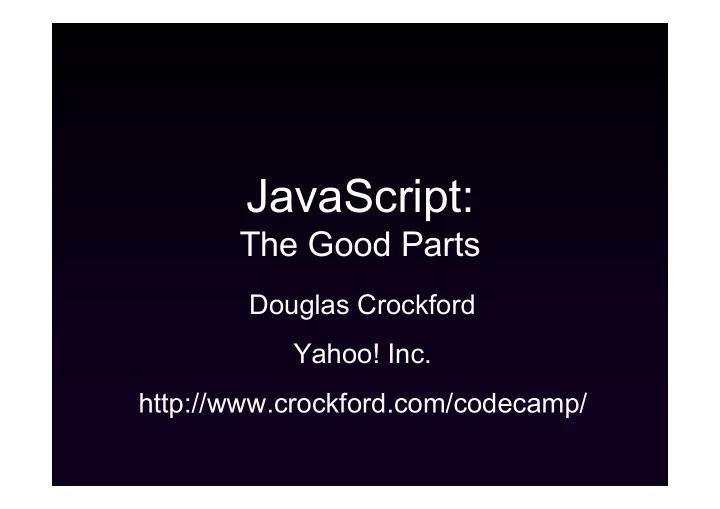

JavaScript: The Good Parts Douglas Crockford Yahoo! Inc. http://www.crockford.com/codecamp/
The World's Most Misunderstood Programming Language
A language of many contrasts.
The broadest range of programmer skills of any programming language. From computer scientists to cut-n-pasters and everyone in between.
Complaints • "JavaScript is not a language I know." • "The browser programming experience is awful." • "It's not fast enough." • "The language is just a pile of mistakes."
Hidden under a huge steaming pile of good intentions and blunders is an elegant, expressive programming language. JavaScript has good parts.
JavaScript is succeeding very well in an environment where Java was a total failure.
Influences • Self • Java prototypal inheritance syntax dynamic objects conventions • Scheme • Perl lambda regular expressions loose typing
Bad Parts • Global Variables • + adds and concatenates • Semicolon insertion • typeof • with and eval • phony arrays • == and != • false, null, undefined, NaN
Transitivity? What's That? • '' == '0' // false • 0 == '' // true • 0 == '0' // true • false == 'false' // false • false == '0' // true • false == undefined // false • false == null // false • null == undefined // true • " \t\r\n " == 0 // true
value = myObject[name]; if (value == null) { alert(name + ' not found.'); } Two errors that cancel each other out.
value = myObject[name]; if (value === undefined) { alert(name + ' not found.'); }
Good features that interact badly • Objects can inherit from other objects. • Functions can be members of objects. • for..in statement mixes inherited functions with the desired data members.
for in is troublesome • Design question: Should for..in do a shallow skim or a deep dredge? • Decision: Deep dredge. The programmer must explicitly filter out the deep members. • Except: They didn't tell anybody! • Consequence: Lots of confusion about how to use for..in.
for in is troublesome • Better Decision: Don't release the language broadly until we have enough experience to have confidence that we made the right choice. • Historical Context: Getting it right at Netscape wasn't an option.
Bad Heritage • Blockless statements if (foo) bar(); • Expression statements foo; • Floating point arithmetic 0.1 + 0.2 !== 0.3 • ++ and -- • switch
Good Parts • Lambda • Dynamic Objects • Loose Typing • Object Literals
Inheritance • Inheritance is object-oriented code reuse. • Two Schools: • Classical • Prototypal
Prototypal Inheritance • Class-free. • Objects inherit from objects. • An object contains a link to another object: Delegation. Differential Inheritance. var newObject = Object.create(oldObject); newObject oldObject __proto__
Prototypal Inheritance if (typeof Object.create !== 'function') { Object.create = function (o) { function F() {} F.prototype = o; return new F(); }; }
new • The new operator is required when calling a Constructor function. • If new is omitted, the global object is clobbered by the constructor. • There is no compile-time or run-time warning.
A Module Pattern var singleton = (function () { var privateVariable; function privateFunction(x) { ...privateVariable... } return { firstMethod: function (a, b) { ...privateVariable... }, secondMethod: function (c) { ...privateFunction()... } }; }());
Module pattern is easily transformed into a powerful constructor pattern.
Closure • A function object contains A function (name, parameters, body) A reference to the environment in which it was created (context). • This is a very good thing.
Style Isn't Subjective block { block { .... .... } } • Might work well in • Works well in other languages JavaScript
Style Isn't Subjective return return { { ok: true ok: false }; }; • SILENT ERROR! • Works well in JavaScript
Style Isn't Subjective return { ok: false };
Style Isn't Subjective return; // semicolon insertion { ok: false };
Style Isn't Subjective return; { // block ok: false };
Style Isn't Subjective return; { ok: false // label };
Style Isn't Subjective return; { // useless ok: false // expression }; // statement
Style Isn't Subjective return; { ok: false; // semicolon }; // insertion
Style Isn't Subjective return; { ok: false; }; // empty statement
Style Isn't Subjective return; { // unreachable statement ok: false; }
Style Isn't Subjective return return; { { ok: false ok: false; }; } • Bad style • Bad results
Working with the Grain
A Personal Journey Beautiful Code
JSLint • JSLint defines a professional subset of JavaScript. • It imposes a programming discipline that makes me much more confident in a dynamic, loosely-typed environment. • http://www.JSLint.com/
WARNING! JSLint will hurt your feelings.
Unlearning Is Really Hard Perfectly Fine == Faulty
It's not ignorance does so much damage; it's knowin' so derned much that ain't so. Josh Billings
The Very Best Part: Stability No new design errors since 1999!
Coming Soon • [ES3.1] ECMAScript Fifth Edition • Corrections • Reality • Support for object hardening • Strict mode for reliability • Waiting on implementations
Not Coming Soon • [ES4] This project has been cancelled. • Instead, [ES-Harmony]. • So far, this project has no defined goals or rules.
Safe Subsets • The most effective way to make this language better is to make it smaller. • FBJS • Caja & Cajita • ADsafe • These subsets will be informing the design of a new secure language to replace JavaScript.
The Good Parts • Your JavaScript application can reach a potential audience of billions. • If you avoid the bad parts, JavaScript works really well. There is some brilliance in it. • It is possible to write good programs with JavaScript.
Recommend
More recommend